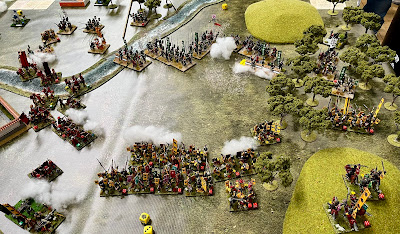As if I haven't got enough books about Gallipoli, Dave Lanchester's stall at Carronade enticed me to buy John Hamilton's book about Billy Sing, the Anzac Angel of Death.
Billy Sing served in the Australian 5th Light Horse, a singularly inappropriate unit to send to Gallipoli! Needless to say, they left their horses back in Egypt. The primary sources about Billy Sing are limited, so this book does give a lot of context about the Gallipoli campaign, and sniping in particular. Over 33,500 British Empire troops died on this strip of land in modern Turkey next to the Dardanelles, along with 15,000 French and 87,000 Ottoman troops. More staggering is that the 324,000 Australians who served in WW1 were all volunteers, and 61,829 died, and 157,156 were wounded. All from a total population of less than five million.
Billy Sing was not a typical Australian volunteer. He was half Chinese at a time when Chinese immigrants faced discriminatory legislation and were deemed unfit for anything other than non-combatant roles. The White Australia Policy was not quite Apartheid, but wasn't far off. Billy was a stockman who could ride and was a skilled marksman, having competed in numerous competitions. It appears that a sympathetic doctor, who had watched him play cricket, turned a blind eye to his ancestry and passed him to join the light horse. Others were not so fortunate and received a certificate with the designation, 'not substantially of European origin'.
When the 5th Light Horse arrived at Gallipoli, Ottoman snipers were picking off the inexperienced troops, including many senior officers. The ranges were close, a few hundred yards, well within the range of standard rifles. The descriptions of the fighting are pretty brutal, along with the appalling conditions the soldiers lived in. The author is a former journalist, and he describes just one Ottoman attack in which 10,000 men were casualties, with the line, 'the sweet nauseating smell of decaying flesh spread like a cloying fog over Gallipoli.'
Billy Sing was one of a team of initially 70 marksmen selected to counter the Ottoman snipers, 'hunting the hunters'. They used the standard Lee-Enfield rifle, but adapted it with homemade periscopes, which were later adopted by the Anzac workshops. The Ottomans sent trench raids to capture some, but the copies made in the Constantinople workshops frequently broke down. They also adapted the sights, strictly against regulations, but most officers recognised it worked. Snipers operated in teams of two with a spotter and managed to gain an ascendancy in this grim struggle. The patience Billy developed while hunting in the bush as a child came in handy in this grim task. They often operated behind camouflaged steel screens, while the equivalent Ottoman ones were made of brick.
The Ottoman equivalent of Billy was nicknamed Abdul the Terrible; aside from an interwar series of sensationalist books by Jack Idress, the evidence appears somewhat limited. Billy was Mentioned in Despatches (later awarded the DCM), having accounted for 201 casualties, although the final tally was probably closer to 300. He survived Gallipoli and a later spell on the Western Front, not without wounds. He married in Edinburgh and later returned (without his wife) to relative obscurity in Australia. He died alone in 1943.
There is a lot of padding in this book, although it is still a good read, about a remarkable soldier. Happily, now properly remembered in the Australian War Museum.
I have walked over the Anzac and other positions on Gallipoli, a pilgrimage still made by many Australians to this day. You are left with the question: why didn't they just embark and land somewhere else?













































